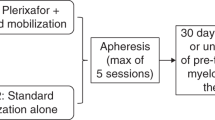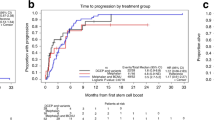Abstract
Forty-one patients with multiple myeloma were treated with a novel stem cell mobilisation regimen. The primary end points were adequate stem cell mobilising ability (>1% circulating CD34-positive cells) and collection (⩾4 × 106 CD34-positive cells/kg), and safety. The secondary end point was activity against myeloma. The regimen (d-TEC) consisted of dexamethasone, paclitaxel 200 mg/m2 i.v., etoposide 60 mg/kg i.v., cyclophosphamide 3 g/m2 i.v., and G-CSF 5–10 μg/kg/day i.v. A total of 84 cycles were administered to these 41 individuals. Patient characteristics included a median age of 53 years, a median of five prior chemotherapy cycles, and a median interval of 10 months from diagnosis of myeloma to first cycle of d-TEC. Seventy-five percent of the patients had stage II or III disease, 50% had received carmustine and/or melphalan previously, and 25% had received prior radiation therapy. Eighty-eight percent of patients mobilised adequately after the first cycle of d-TEC and 91% mobilized adequately after the second cycle. An adequate number of stem cells were collected in 32 patients. Of the remaining nine patients, three mobilised, but stem cells were not collected, two mobilised but stem cell collection was <4 × 106 CD34-positive cells/kg, three did not mobilise, and one died of disease progression. Major toxicities included pancytopenia, alopecia, fever and stomatitis. One patient died from multi-organ failure and progressive disease. Fifty percent of evaluable patients demonstrated a partial response and 28.6% of patients had a minor response. This novel dose-intense regimen was safe, capable of stem cell mobilisation and collection, even in heavily pre-treated patients, and active against the underlying myeloma. Bone Marrow Transplantation (2001) 28, 137–143.
This is a preview of subscription content, access via your institution
Access options
Subscribe to this journal
Receive 12 print issues and online access
$259.00 per year
only $21.58 per issue
Buy this article
- Purchase on Springer Link
- Instant access to full article PDF
Prices may be subject to local taxes which are calculated during checkout
Similar content being viewed by others
References
Fermand JP, Ravaud P, Chevret S et al. High-dose therapy and autologous peripheral blood stem transplantation in multiple myeloma: up-front or rescue treatment? Results of a multicenter sequential randomized clinical trial Blood 1998 92: 3131–3136
Barlogie B, Jaganath S, Desikan KR et al. Total therapy with tandem transplants for newly diagnosed multiple myeloma Blood 1999 93: 55–65
Attal M, Harousseau JL, Stoppa AM et al. A prospective, randomized trial of autologous bone marrow transplantation and chemotherapy in multiple myeloma New Engl J Med 1996 335: 91–97
Boiron J-M, Marit G, Faberes C et al. Collection of peripheral blood stem cells in multiple myeloma following single high-dose cyclophosphamide with and without recombinant human granulocyte–macrophage colony-stimulating factor (rhGM-CSF) Bone Marrow Transplant 1993 12: 49–55
Tricot G, Jaganath S, Vesole D et al. Peripheral blood stem cell transplants for multiple myeloma: identification of favorable variables for rapid engraftment in 225 patients Blood 1995 85: 588–596
Demuynck H, Delforge M, Verhoef G et al. Comparative study of peripheral blood progenitor cell collection in patients with multiple myeloma after single-dose cyclophosphamide combined with rhGM-CSF or rhG-CSF Br J Haematol 1995 90: 384–392
Kelsey SM, Hazel D, Murrell C, Newland AC . GM-CSF for peripheral blood stem cell harvest in myeloma (letter) Br J Haematol 1996 92: 505
Prince HM, Imrie K, Sutherland DR et al. Peripheral blood progenitor cell collections in multiple myeloma: predictors and management of inadequate collections Br J Haematol 1996 93: 142–145
Goldschmidt H, Hegenbart U, Haas R, Hunstein W . Mobilization of peripheral blood progenitor cells with high-dose cyclophosphamide (4 or 7 g/m2) and granulocyte colony-stimulating factor in patients with multiple myeloma Bone Marrow Transplant 1996 17: 691–697
Demirer T, Buckner CD, Gooley T et al. Factors influencing collection of peripheral blood stem cells in patients with multiple myeloma Bone Marrow Transplant 1996 17: 937–941
Martinez E, Sureda A, De Dalmases C et al. Mobilization of peripheral blood progenitor cells by cyclophosphamide and rhGM-CSF in multiple myeloma Bone Marrow Transplant 1996 18: 1–7
Long GD, Chao NJ, Hu WW et al. High-dose etoposide-based myeloablative therapy followed by autologous blood progenitor cell rescue in the treatment of multiple myeloma Cancer 1996 78: 2502–2509
Alegre A, Tomas JF, Martinez-Chamorro C et al. Comparison of peripheral blood progenitor cell mobilization in patients with multiple myeloma: high-dose cyclophosphamide plus GM-CSF vs G-CSF alone Bone Marrow Transplant 1997 20: 211–217
Goldschmidt H, Hegenbart U, Wallmeier M et al. Factors influencing collection of peripheral blood progenitor cells following high-dose cyclophosphamide and granulocyte colony-stimulating factor in patients with multiple myeloma Br J Haematol 1997 98: 736–744
Omede P, Tarella C, Palumbo A et al. Multiple myeloma: reduced plasma cell contamination in peripheral blood progenitor cell collections performed after repeated high-dose chemotherapy courses Br J Haematol 1997 99: 685–691
Schiller G, Vescio R, Freytes C et al. Autologous CD34-selected blood progenitor cell transplants for advanced multiple myeloma Bone Marrow Transplant 1998 21: 141–145
Desikan KR, Barlogie B, Jaganath S et al. Comparable engraftment kinetics following peripheral-blood stem-cell infusion mobilized with granulocyte colony-stimulating factor with or without cyclophosphamide in multiple myeloma J Clin Oncol 1998 16: 1547–1553
Marit G, Thiessard F, Faberes C et al. Factors affecting both peripheral blood progenitor cell mobilization and hematopoietic recovery following autologous blood progenitor cell transplantation in multiple myeloma patients: a monocentric study Leukemia 1998 12: 1447–1456
Abonour R, Scott KM, Kunkel LA et al. Autologous transplantation of mobilized peripheral blood CD34+ cells by immunomagnetic procedures in patients with multiple myeloma Bone Marrow Transplant 1998 22: 957–963
Gupta D, Bybee A, Cooke F et al. CD34+-selected peripheral blood progenitor cell transplantation in patients with multiple myeloma: tumour cell contamination and outcome Br J Haematol 1999 104: 166–177
Vescio R, Schiller G, Stewart AK et al. Multicenter phase III trial to evaluate CD34(+) selected versus unselected autologous peripheral blood progenitor cell transplantation in multiple myeloma Blood 1999 93: 1858–1868
Facon T, Harousseau JL, Maloisel F et al. Stem cell factor in combination with filgrastim after chemotherapy improves peripheral blood progenitor cell yield and reduces apheresis requirements in multiple myeloma patients: a randomized, controlled trial Blood 1999 94: 1218–1225
Gandhi M, Jestice H, Scott M et al. A comparison of CD34+ cell selected and unselected autologous peripheral blood stem cell transplantation for multiple myeloma: a case controlled analysis Bone Marrow Transplant 1999 24: 369–375
Abraham R, Chen C, Tsang R et al. Intensification of the stem cell transplant induction regimen results in increased treatment-related mortality without improved outcome in multiple myeloma Bone Marrow Transplant 1999 24: 1291–1297
Boccadoro M, Omede P, Dominietto A et al. Multiple myeloma: the number of reinfused plasma cells does not influence outcome of patients treated with intensified chemotherapy and PBPC support Bone Marrow Transplant 2000 25: 25–29
Dyson PG, Horvath N, Joshua D et al. CD34+ selection of autologous peripheral blood stem cells for transplantation following sequential cycles of high-dose therapy and mobilization in multiple myeloma Bone Marrow Transplant 2000 25: 1175–1184
Bensinger WI, Longin K, Appelbaum F et al. Peripheral blood stem cells (PBSCs) collected after recombinant granulocyte colony stimulating factor (rhG-CSF): an analysis of factors correlating with the tempo of engraftment after transplantation Br J Haematol 1994 87: 825–831
Mahe B, Milpied N, Hermouet S et al. G-CSF alone mobilizes sufficient peripheral blood CD34+ cells for positive selection in newly diagnosed patients with myeloma and lymphoma Br J Haematol 1996 92: 263–268
Kobbe G, Sohngen D, Bauser U et al. Factors influencing G-CSF-mediated mobilization of hematopoietic progenitor cells during steady-state hematopoiesis in patients with malignant lymphoma and multiple myeloma Ann Hematol 1999 78: 456–462
Cook G, Marinaki P, Farrell E et al. Peripheral blood progenitor cell mobilisation in patients with multiple myeloma following oral idarubicin and dexamethasone (Z-Dex) induction therapy Leukemia 1997 11: (Suppl. 5) S35–S40
Engelhardt M, Winkler J, Waller J et al. Blood progenitor cell (BPC) mobilization studied in multiple myeloma, solid tumor and non-Hodgkin's lymphoma patients after combination chemotherapy and G-CSF Bone Marrow Transplant 1997 19: 529–537
Kiel K, Cremer FW, Ehrbrecht E et al. First and second apheresis in patients with multiple myeloma: no differences in tumor load and hematopoietic stem cell yield Bone Marrow Transplant 1998 21: 1109–1115
Weaver CH, Zhen B, Schwartzberg LS et al. Phase I–II evaluation of rapid sequence tandem high-dose melphalan with peripheral blood stem cell support in patients with multiple myeloma Bone Marrow Transplant 1998 22: 245–251
Stewart DA, Guo D, Morris D et al. Superior autologous blood stem cell mobilization from dose-intensive cyclophosphamide, etoposide, cisplatin plus G-CSF than from less intensive chemotherapy regimens Bone Marrow Transplant 1999 23: 111–117
Lokhorst HM, Sonneveld P, Cornelissen JJ et al. Induction therapy with vincristine, adriamycin, dexamethasone (VAD) and intermediate-dose melphalan (IDM) followed by autologous or allogeneic stem cell transplantation in newly diagnosed multiple myeloma Bone Marrow Transplant 1999 23: 317–322
Rajkumar SV, Fonseca R, Lacy NQ et al. Autologous stem cell transplantation for relapsed and primary refractory myeloma Bone Marrow Transplant 1999 23: 1267–1272
Lefrere F, Makke J, Fermand J et al. Blood stem cell collection using chemotherapy with or without systematic G-CSF: experience in 52 patients with multiple myeloma Bone Marrow Transplant 1999 24: 463–466
Vela-Ojeda J, Tripp-Villanueva F, Montiel-Cervantes L et al. Prospective randomized clinical trial comparing high-dose ifosfamide + GM-CSF vs high-dose cyclophosphamide + GM-CSF for blood progenitor cell mobilization Bone Marrow Transplant 2000 25: 1141–1146
Cremer FW, Kiel K, Wallmeier M et al. Leukapheresis products in multiple myeloma: lower tumor load after mobilization with cyclophosphamide plus granulocyte colony-stimulating factor (G-CSF) compared with G-CSF alone Exp Hematol 1998 26: 969–975
Bilgrami S, Feingold JM, Bona RD et al. Dose-intense paclitaxel, etoposide and cyclophosphamide: a safe and active regimen for tumor cytoreduction and stem cell mobilization in metastatic breast cancer Bone Marrow Transplant 2000 25: 123–130
Miller AB, Hoogstraten B, Staquet M, Winkler A . Reporting results of cancer treatment Cancer 1981 47: 207–214
Siena S, Bregni M, Belli N et al. Flow cytometry for clinical estimation of circulating hematopoietic progenitors for autologous transplantation in cancer patients Blood 1991 77: 400–409
Gregory CJ, Eaves AC . Human marrow cells capable of erythropoietic differentiation in vitro: definition of three erythroid colony responses Blood 1977 49: 855–864
Blade J, Samson D, Reece D et al. Criteria for evaluating disease response and progression in patients with multiple myeloma treated by high-dose therapy and hematopoietic stem cell transplantation. On behalf of the Myeloma Subcommittee of the EBMT (European Group for Blood and Marrow Transplant), Chronic Leukaemia Working Party and the Myeloma Working Committee of the IBMTR (International Bone Marrow Transplant Registry) and ABMTR (Autologous Blood and Marrow Transplant Registry) Br J Haematol 1998 102: 1115–1123
Dimopoulos MA, Arbuck S, Huber M et al. Primary therapy of multiple myeloma with paclitaxel (taxol) Ann Oncol 1994 5: 757–759
Demirer T, Rowley S, Buckner CD et al. Peripheral-blood stem-cell collections after paclitaxel, cyclophosphamide, and recombinant human granulocyte colony-stimulating factor in patients with breast and ovarian cancer J Clin Oncol 1995 13: 1714–1719
Gockerman JP, Bartolucci AA, Nelson MO et al. Phase II evaluation of etoposide in refractory multiple myeloma: a Southeastern Cancer Study Group Trial Cancer Treat Rep 1986 70: 801–802
Author information
Authors and Affiliations
Rights and permissions
About this article
Cite this article
Bilgrami, S., Bona, R., Edwards, R. et al. Dexamethasone, paclitaxel, etoposide, cyclophosphamide (d-TEC) and G-CSF for stem cell mobilisation in multiple myeloma. Bone Marrow Transplant 28, 137–143 (2001). https://doi.org/10.1038/sj.bmt.1703126
Received:
Accepted:
Published:
Issue Date:
DOI: https://doi.org/10.1038/sj.bmt.1703126



